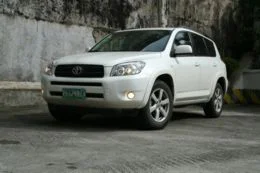October 19, 2006
Review: 2006 Toyota RAV4
A lot is expected from the all-new Toyota RAV4. Aside from being the newest offering in the compact SUV segment, this model was responsible for popularizing the concept of the “cute-ute” way back in the 1990s. The second iteration caused an equal amount of awe with Toyota pushing the RAV4’s styling to a new direction. Compared to its perennial rival, the Honda CR-V, the RAV4 looked more advanced with its rakish design and exaggerated features be it the Mk. I or Mk. II models. Having found the right success recipe though, Toyota decided to play it safe with the Mk. III. Designers and engineers toyed around with the standards set by its predecessor—a good starting point, considering RAV4s were always handsome and always driver-oriented.
The resulting SUV is more evolution than revolution. Although the new RAV4 looks undeniably good, it carries a similar angular motif set by the previous model. As a whole, it’s as if Toyota engineers had an enlarging ray and increased the proportions by 20 percent. The overall shape especially the lamps, grille and side mirrors will look familiar to anyone who’s spent time with the older RAV4 model. With clamors for more interior room though, Toyota extended the RAV4 from the B-Pillar backward. The extended rear doors and longer greenhouse made the once cute SUV into somewhat a mid-sized mutant thing. It looks modern—echoing designs now seen in some JDM (Japanese Domestic Market) model Toyotas. It may be overcritical, but there’s a lack of surface detail especially at the doors making the RAV4 look too long, too tall and too narrow.
But while the shape is all too predictable from Toyota, it’s inside where the RAV4 has made the most leaps and bounds. For the most part, it looks Lexus with the new “wing” shaped design. The symmetry between left and right sides present a very grown up flavor while retaining a lot of the sporty characteristics associated with the RAV4. The 3-spoke steering wheel is covered with leather and features adjustment for both tilt and reach. The three-cluster instrumentation is pure eye candy (personally, one of the best gauges I’ve ever seen). The ventilation controls look as if they operate by the use of dials, but upon closer inspection, it’s actually a push button affair. Since this is a 4WD model, it also comes with black leather seats too. The interior material quality has been upped too, but there are some areas where there’s a lack of texture. It’ solid, tough and durable though. However, there are some natty bits such as the push-button convenience box just above the glove box, which feel clunky and will undoubtedly be one of the first trim pieces to break off.
The driver sits high in the RAV4, while the dash bulges making the car feel bigger than it really is. Overall ergonomics are spot on especially thanks to the power driver’s seat. Again, there are some minor quirks such as the hazard button being on the wrong side of the dash. Having the bulging center makes pushing it a bit too difficult; as if during the switch between right-hand to left-hand driver, the interior designers forgot to flip the hazard to the appropriate side (occupied coincidentally by the 4WD lock function). The climate controls are a bit confusing at first, but comes naturally after a while.
On the road, the RAV4 feels grown up as its proportions suggest. Overall, it feels more cumbersome. The initial throttle response lacks bit, although the engine generates a healthy does of power and torque. The sound’s not exactly an aural joy, but it’s unobtrusive and smooth for most. Once it gets going though, the RAV4 can push its heft quite well. One theory for the RAV4’s lack of response is due to its gearbox. Toyota has squandered its chance in giving the RAV4 a five-speed box instead of a four-speed unit. The brakes though are superb: grabby and fade-free with a good firm pedal feel.
For the first time, Toyota has shunned permanent all-wheel drive on the RAV4 for something they’ve dubbed Active Torque Control 4WD. In principle, it works like Honda’s Real-Time All-Wheel Drive system where power is sent first to the front wheels and splits the traction accordingly when the computer detects a slip. In Toyota’s case though, there’s a dash-mounted torque lock switch that splits power 50/50 (up to 40 km/h) during tough excursions to the park.
The 1.7 million peso asking price certainly puts the RAV4 above the entry-level SUV category. But, considering the exclusive features it has: electric power steering, eight airbags, power driver’s seat, tilt/telescopic steering wheel, dual zone climate control and rear luggage net—it’s looking like a steal. In other markets, the RAV4 is made available with third row seating, but here, it’s a strict five-seater. In the Toyota’s model range, the RAV4 is pretty much the premium compact SUV of the bunch—think Toyota’s version of the X3 and you’re not that far off. And as such, if you’re moneyed and looking for something luxurious, modern and refined, look no further than the Toyota RAV4.
Filed Under:
Compact SUV,
Driver's Seat,
Toyota RAV4
Subscribe to:
Post Comments (Atom)















No comments:
Post a Comment
Feel free to comment or share your views. Comments that are derogatory and/or spam will not be tolerated. We reserve the right to moderate and/or remove comments.